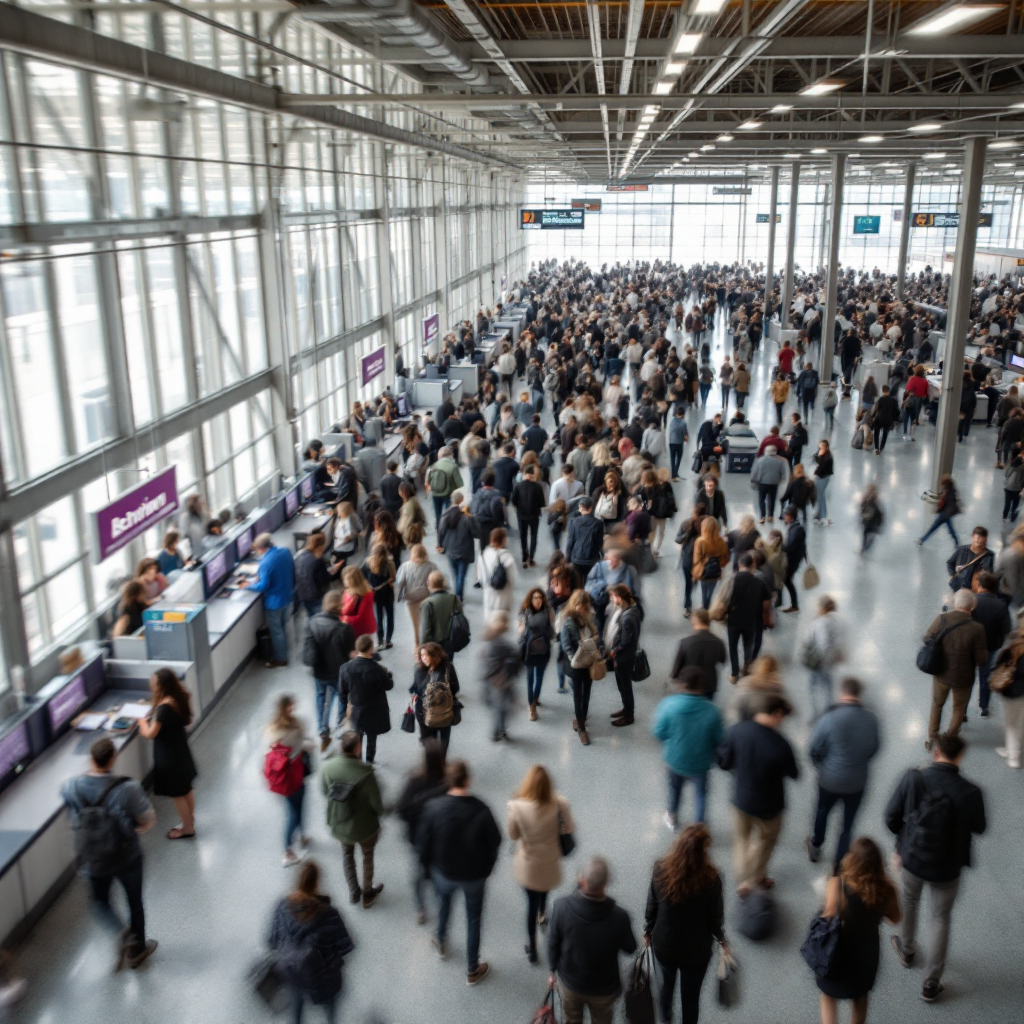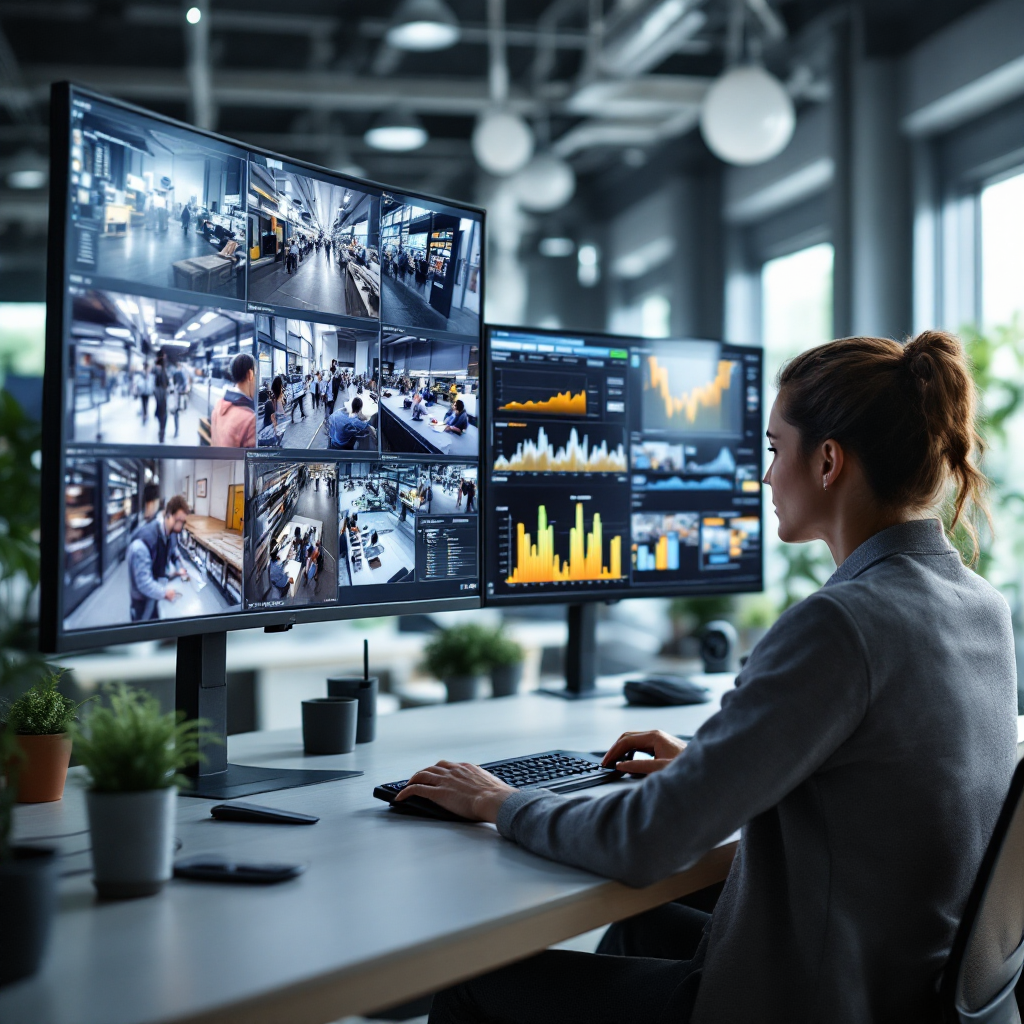Queue video analytics with existing CCTV: an introduction
Ticket halls grow busy, and operators face daily pressure to manage flow and reduce friction. AI transforms how teams see crowds and act. By converting existing CCTV into sensors, operators get structured events, and teams can act faster. Visionplatform.ai turns cameras into a real-time operational feed so staff can monitor queues as if they had thousands of sensors. This turns passive cameras into active tools that help improve customer experience and business operations.
Using AI, teams extract metrics from live video and archived streams. For example, a simple deployment can show occupancy, session lengths, and service time by counter. A solid deployment also links alerts and dashboards to business intelligence systems so decisions are data driven. According to a guide on people counting, tracking visitor flow through video data “allows you to improve the layout and service by reducing congestion and wait times” People Counting & Footfall Analytics | Complete Guide. This quote shows why operators add vision to operations. It also explains why integration with existing systems matters.
Many operators worry about compliance and vendor lock-in. Visionplatform.ai addresses those worries by keeping models and data on-prem or in customer-controlled clouds. The platform integrates via a standard API so events stream to existing VMS and dashboards. In short, AI lets teams shift from reactive security alarms to proactive operational insights. Therefore, you can better optimize staffing, routing, and layout with minimal disruption. Also, you can preserve privacy and control while you scale.
AI-powered video analytics and detection analytics for queue density and queue length
AI-powered video analytics can measure queue density and estimate queue length with surprising accuracy. Modern computer vision algorithms detect people, track paths, and compute density heatmaps. Then, machine learning models classify behaviors and flag abnormal slowdowns. Because of this, transit hubs can allocate staff during peaks and reduce crowding. In practice, effective queue analytics helped airports cut average wait time by as much as 30% in some cases 5 Best Strategies for Improving Queue Management in Airports. That statistic explains why several operators invest in automated sensing.
Detection analytics combine object detection and tracking to give granular detail. For example, length detection and object detection and tracking let systems separate moving groups and static clusters. That supports accurate queue length measurement and fair allocation of resources. Vendors also show results: one QMS implementation reported a 25% increase in throughput and a 15% reduction in queue abandonment after adding real-time monitoring A Queue Management System Implementation Guide – Wavetec. These numbers prove the operational value of queue video analytics.

Detection models work at the edge or server side. They run as ai-based video analytics or as custom video analytics when rules must match site needs. For stations with unique layouts, a custom analytics model can reduce false detections. Visionplatform.ai supports that flexibility by letting teams pick a model from a library, refine it on-site, or build new models that use your video footage. This reduces false positives and ensures that length detection and queue density measurements match real operational definitions.
AI vision within minutes?
With our no-code platform you can just focus on your data, we’ll do the rest
Real-time video surveillance for people counting and wait times
Real-time video surveillance powers live situational awareness. When live video arrives, AI extracts counts, trajectories, and dwell times. Operators then receive a quick snapshot of queue size and service time at each counter. The same system also supports historical trend analysis with real-time and historical reports that feed business intelligence. This helps teams forecast staffing needs and adjust service lanes before delays grow.
People counting and dwell analytics rely on robust computer vision algorithms and clear camera placement. A single camera can do people counting for a small zone, while multiple cameras provide redundancy for larger halls. Edge event manager setups reduce latency by processing events locally. Then, events stream to dashboards and the operations stack. For example, a system that sends an alert when wait times cross a threshold allows supervisors to respond within minutes. The solution also supports notification rules for managers and front-line staff.
Real-time video also supports special features. For instance, automated queue reshaping uses occupancy, flow rate, and service time to suggest opening new counters or staffing a temporary desk. If a station integrates with a VMS, an API can deliver detection events into scheduling and workforce tools. For related airport work, see our deep dive on AI video analytics for airports which explains how the same principles scale for larger, multi-hall environments.
Smart queue management: alerts and real-time AI queue detection
Smart queue systems blend detection with rules and alerts. A smart queue flags bottlenecks, and then it triggers an alert to staff, or it sets an automated redirect sign. The platform can push a notification to a manager or connect to a public display that diverts passengers to shorter lines. Smart actions reduce queue density while preserving flow.
Operators rely on a chain: cameras for monitoring, AI models for detection, and a management layer for orchestration. The detection layer often includes object taken proximity speed detection and fall monitoring to cover common safety events. It can also run tailgating detection vehicle tailgating detection for mixed passenger and vehicle access areas. Smart queue logic uses occupancy and flow rate to maintain throughput. When conditions change, the system triggers an alert and logs an intuvision va event for audit trails.
Visionplatform.ai supports edge deployments and streaming so teams keep control of their data. The platform sends structured events via MQTT or webhooks to business intelligence and operation stacks. This lets security and operations share a single source of truth. For transit-specific examples, read about AI video analytics for train stations and how platforms integrate with crowd management. Next, we will look at analytics software and concrete use cases that show how to apply these capabilities.
AI vision within minutes?
With our no-code platform you can just focus on your data, we’ll do the rest
Analytics software and use cases for CCTV queue video analytics
Analytics software turns detections into actions. A good analytics solution provides dashboards, trend reports, and API hooks so teams measure KPIs such as service time and average wait time. Operators then analyze peak patterns and plan staffing. For example, an analytics people counter vehicle counter setup supports combined people and vehicle flows in intermodal hubs. Use cases stretch beyond transit. Retail checkout optimization, large-venue ingress, and airport baggage hall flow all benefit.

Use cases show the breadth. At an airport, vehicle queue airport solutions and baggage hall occupancy analytics help schedule gates and staff. At a train station, platform crowd management with cameras and automated queue signage prevent unsafe crowding. For practical steps, integrations like Milestone XProtect allow direct integration; see our page on Milestone XProtect integration for airport CCTV. The same software features support business intelligence too, feeding important business intelligence into planning and OEE analysis.
Feature lists often include object detection and tracking, counting person tailgating detection vehicle, and speed detection people counting parking. Systems also include edge analytics people counter vehicle and vehicle counter intuvision edge custom modules for specific deployments. For retail or checkout lanes, detection people counting parking occupancy and counting parking occupancy vehicle counting can inform staffing of checkout lanes. One platform can therefore serve security, operations, and retail managers at once. For airport security queue analytics, our case studies cover common architectures and outcomes airport security queue analytics with cameras.
Ethical use of AI, CCTV and video surveillance in queue management
Ethics and privacy must guide deployment. The acceleration of video data collection necessitates careful consideration of privacy implications and transparent governance Video Analytics – an overview | ScienceDirect Topics. Operators must avoid storing identifiable features when not needed and must document retention and access. Many regions also bound what processing is allowed under laws such as the EU AI Act. Therefore, keep data local and auditable whenever possible.
Best practice includes on-prem processing and clear data minimization rules. Visionplatform.ai aligns with that approach by default. The platform supports on-prem and edge deployments so customers own models and data. That helps with GDPR and EU AI Act readiness. In addition, transparent configuration and an auditable event log help operators meet compliance needs. For crowd monitoring, mixed-sensor approaches are discussed in research that warns “most crowd monitoring systems feature one type of sensor” and encourages richer data but controlled usage Enhancing Crowd Monitoring System Functionality through Data ….
Finally, ethical deployment balances security and service. Use minimal retention, apply anonymization, and train models on relevant, consented data. Staff should receive clear guidance and the public should get signage about monitoring. When operators adopt these principles, they can improve customer satisfaction while protecting privacy and building trust.
FAQ
What is queue video analytics and how does it work?
Queue video analytics uses AI to analyze camera feeds and extract structured events about people and lines. It detects people, measures density, and reports metrics like occupancy and service time so operators can optimize flow.
Can existing CCTV systems be used for queue analytics?
Yes, existing cctv can be repurposed with AI models that plug into your VMS. Visionplatform.ai supports ONVIF/RTSP cameras and integrates via API so teams can use current equipment.
How accurate is people counting from video?
Accuracy varies with camera angle and congestion, but modern computer vision algorithms provide reliable counts in many conditions. Regular calibration and site-specific model tuning can further improve results.
What benefits do real-time alerts offer to staff?
Real-time alerts let staff respond before issues escalate, reducing wait times and preventing queue collapse. Alerts also feed dashboards so supervisors can reassign staff dynamically.
How does video analytics protect passenger privacy?
Privacy is maintained by processing at the edge, minimizing retention, and avoiding facial recognition unless legally justified. Transparent policies and local control of data are essential for compliance.
What metrics should transit operators monitor?
Key metrics include queue length, average wait time, throughput, and occupancy. Monitoring these metrics helps optimize staffing, signage, and counter allocation in real-time.
Can AI models be customized for a station?
Yes, custom analytics can be created to match site-specific layouts and rules. Visionplatform.ai supports model refinement on local footage so deployments match operational needs.
How do integrations with business systems work?
Integrations use APIs, webhooks, or MQTT to push structured events into workforce, BI, or SCADA systems. This makes vision data actionable across security and operations.
What is the role of edge processing?
Edge processing reduces latency and keeps data local, improving real-time performance and compliance. It helps achieve fast detections without sending all video to the cloud.
Where can I see practical examples for airports and stations?
Visionplatform.ai publishes case studies and integration guides for airports and train stations, including baggage hall and platform crowd management examples. See our pages on AI video analytics for airports, airport security queue analytics with cameras, and AI video analytics for train stations for real deployments and recommendations.

